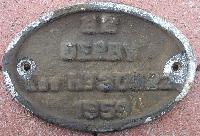Class 127 Derby 4-car DMUs
| Vehicles | Type | TOPS | Seating (all 2nd class) | Weight | Lot no. | Diagram | Design Code |
|---|---|---|---|---|---|---|---|
| 51591-51650 | DMBS | 127 | 78 seats | 40 tons | 30521 | BR 588 | |
| 76 seats | 40 tons | BR 588 | DQ 227 | ||||
| 59589-59618 | TSL | 186 | 90 seats | 30 tons | 30522 | BR 589 | DT 214 |
| 86 seats | 30 tons | DT 226 | |||||
| 59619-59648 | TS | 186 | 106 seats | 29 tons | 30523 | BR 590 | DT 208 |
| 98 seats | 29 tons | DT 229 |
The DMBS was altered to give through access between the saloons reducing the seating by two. The TSL seats were reduced by four when the vehicles were gangwayed, they already had through access within the vehicle for access to the lavatories. The TS seating was reduced by eight when gangwayed as access between saloons was also required.
Despite their differences the TS & TSL vehicles were both given TOPS Class 186. The practicaly identical Class 115 TS vehicles were given Class 173.
Worksplates
Worksplates were carried on the vehicle solebars to identify the builder and lot number. Many of the worksplate images on the website are from the collections of Simeon Gaskell, John Horne and Tony Spencer.


Summary
Background
Description
Power Train
Interiors
Works Photos
Diagrams & Design Codes
Driving Instructions
Numbering
Liveries
Operations
Accidents
Parcel Use
Images
Details about preserved Class 127s can be found here.
Also relavant is the article "Working the DMUs" by Cricklewood Driver Arno Brooks.


